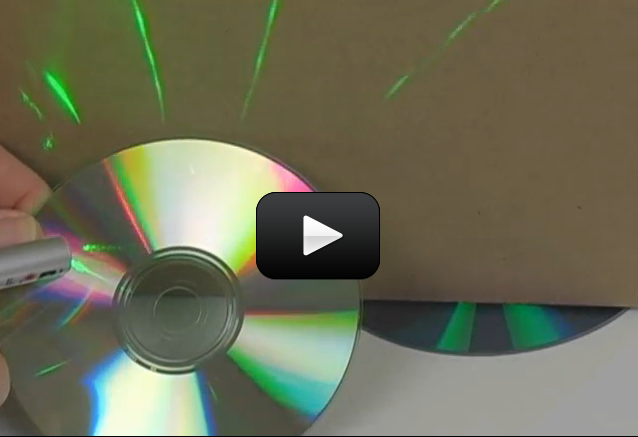We’re going to use a laser pointer and a protractor to measure the microscopic spacing of the data tracks on a DVD and a CD. The really cool part is that you’re going to use an interference pattern to measure the spacing of the tracks, something that you can’t normally see with your eyes.
Interference is what happens when waves smack into each other. When the waves collide, if the two highest or two lowest points of the waves are lined up, then they add together to form a larger amplitude which is seen as a bright spot of light. However, if a peak and a trough line up, then they cancel each other out and there is a dark area in the pattern (see the dark spaces in the line?).
[am4show have=’p8;p9;p19;p46;p89;p99;’ guest_error=’Guest error message’ user_error=’User error message’ ]
On the CD or DVD, when white light shines on the surface, it makes a shimmering rainbow of colors. It does this because of diffraction, which is a more complicated form of interference.
We’re going to measure the data track spacing using a diffraction pattern and a little math. Here’s how to do it:
Materials:
- Laser pointer (red works fine in a dark room)
- CD
- DVD
- Protractor
- Index card
- Scissors
- Tape
- Cardboard box
- Stack of books
- Marker
- Pencil
- Clothespin
- Brass fastener
- Hot glue gun
- Piece of grid paper
The equation to determine the distance is:
dm = m λ / (sin θm – sin θi)
where λ is the wavelength of the laser, m = the order of the refraction ray, and d is the track spacing.
Watch the video to see how to do the calculations!
Questions:
- Does a CD or DVD hold more data? How can you tell?
- Is the track spacing larger, the same, or smaller for a DVD as a CD?
- What is a diffraction grating?
- How is diffraction different or the same as interference?
- Why do you get more than one reflection when you shine the laser on the back surface of a CD? [/am4show]


CDs work by reflecting LASER light which is then picked up by a special sensor. Although the LASERs used in CD players are strong enough to hurt our eyes, they are low enough in power so as to not affect the surface of the CD. The CD would only be affected if a much more powerful LASER was used. In that situation, the CD wouldn’t be able to reflect all the energy and would start to heat up. Possibility to the point where a hole is melted into the disc.
when you shine a laser on a CD does it affect it thank you
I know – it’s one of the more advanced projects. But it sounds like you got it to work? 🙂
That was a really hard formula to solve even with a calculator.XD
Oops! Sorry about that… I’ll have my team fix it right away!
The video isn’t showing up for me. Am I missing it?